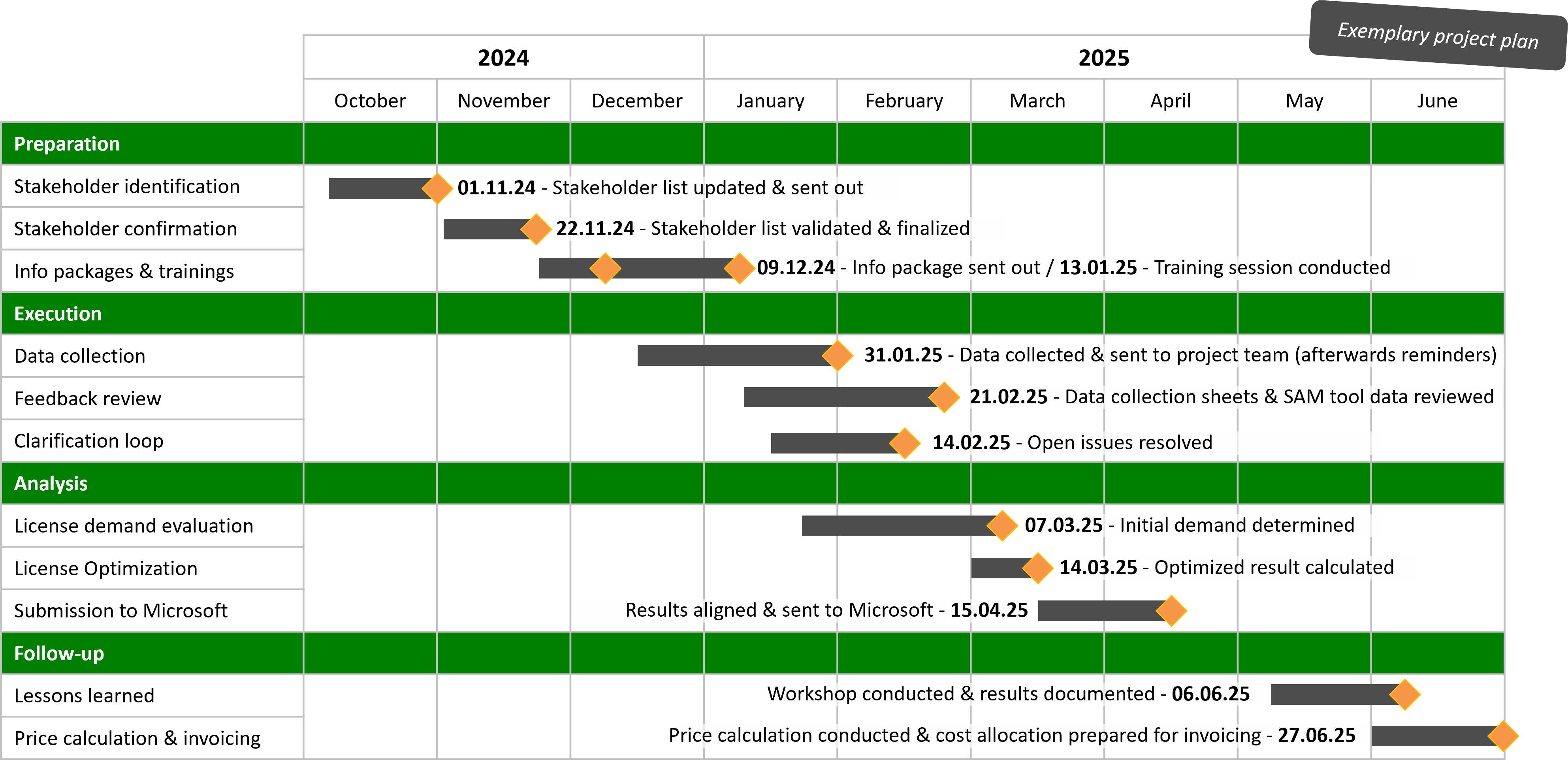
Between duty and potential: A project report on a Microsoft True-Up
What at first glance appears to be a mandatory annual task in license management turns out on closer inspection to be a project with great potential for optimization: the annual Microsoft True-Up report. The overarching goal is a comparison in which companies tell Microsoft how many licenses they have actually used in the past year. Our client in this project was a globally active, listed industrial group with a focus on steel processing. Our task was to organize the true-up reporting for almost 350 group companies, to consolidate the license requirements and to revalue them at group level. The challenge was not only the amount of data, but also the complexity of the group structure, changing contact persons and the technical background knowledge within the units.
What is a Microsoft True-Up?
For all those who are not familiar with the term "Microsoft True-Up": This is an annually recurring process in which companies compare their actual use of Microsoft products with the originally agreed license scope. The basis for this is a so-called Microsoft Enterprise Agreement. This is a long-term contract with which companies license software for many users or devices at fixed conditions. In this contract model, it is possible for new devices, users or services to be added over the course of the year without the need to place an order immediately. These changes in demand are collected and reported to Microsoft once a year, around the contract deadline. The idea behind this is to reduce administration costs by only billing once a year. The prerequisite for this is an overview of your own license requirements.
Project Report
The project began with an inventory: Which companies are required to report this year? Which contacts are currently responsible? Which processes and templates proved successful in the previous year - and where is there potential for improvement? We updated the stakeholder list accordingly, revised the previously used recording template and expanded the process description. Our focus was on reducing the information queries to the minimum required for the true-up. At the same time, automated pre-filling and the transfer of information from other spreadsheets noticeably reduced the workload. This meant that data did not have to be entered multiple times, which not only saved time but also significantly reduced the susceptibility to errors. In addition, we integrated a progress overview that makes the degree of completion of the template transparent. This was a helpful element in order to better understand the status of the feedback and to be able to make more targeted adjustments. In addition, the decision to establish a True-Up-specific function mailbox for the project was a significant improvement. This enabled us to ensure that all inquiries, feedback and documents were collected centrally and that no process was lost. For the units, this also meant a fixed contact person, clear communication channels and fewer frictional losses.
The revised version of the template was easier for the contact persons to fill in and resulted in noticeably better data quality. This significantly reduced the time and effort required for data collection, reconciliation and evaluation. The early communication to the units also proved its worth - including accompanying training documents and Q&A sessions. Many questions could be clarified directly and the participants were better prepared for the data collection. Overall, the feedback rate and quality were very satisfactory. The agreed deadlines were also met for the most part, which is not a matter of course given the Group structure. In the event of delays, it proved particularly effective to send reminders specifically to the affected units and their divisional managers instead of sending a general notice to all contact persons.
The evaluation of the reported requirements was much more efficient this year. Both the analysis of data from the license management tool and the evaluation of manually reported information could be carried out faster and more reliably. This was not least due to the experience gained from the previous year - we were able to optimize many things that were still time-consuming and error-prone back then. Good cooperation within the project team, close coordination with the customer and a clearly structured project plan made a decisive contribution to success. As a result, we were able to create a complete, consolidated true-up report. This is not only relevant for reporting to Microsoft, but also forms the basis for internal invoicing to the individual Group companies.
Exemplary Project Plan

Review & conclusion
Looking back, many of the implemented improvements have proven to be effective. At the same time, there are some aspects that we would like to develop further in the coming year. These include, above all, even higher data quality as well as more clearly structured templates and training documents, which should make it even easier to use. For units that encountered difficulties this year, we are planning a targeted exchange in order to clarify open questions at an early stage. In future, we would like to include topics such as RDS-CALs even more in our training materials. In view of the upcoming extension of the Enterprise Agreement, the focus will also shift to optimizing the software products used - with the aim of reducing licensing requirements as effectively as possible.
In summary, it can be said that the annual Microsoft True-Up report is far more than just a mandatory task in license management. The transparency gained about actual license usage and requirements enables targeted control, especially with a view to future contract renewals, as well as long-term, demand-oriented optimization of the licenses used. Thanks to our many years of cooperation with our client, we have been able to continuously optimize the true-up process and thus ensure a smooth workflow - despite the size and complexity of the Group. For this reason, I am already looking forward to next year's true-up.